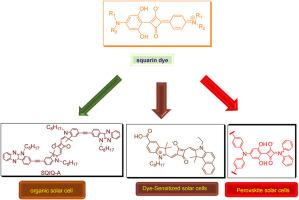Squaraine dye: Promising strategies to boost power conversion efficiencies of OPV cells
IF 4.2
3区 工程技术
Q2 CHEMISTRY, APPLIED
引用次数: 0
Abstract
Organic photovoltaic cells (OPVs) are one of the most promising technologies in the field of renewable energy. Bulk heterojunction (BHJ), dye-sensitized solar cells (DSSCs) and Perovskite solar cells (PKSCs) are recent OPVs that have attracted a lot of attention in the sustainable energy field. Squaraine is an important class of organic dyes with efficient absorption and stability in the visible and near infrared regions. Because of this ability, squaraine is a vital candidate for its photovoltaic applications in organic solar cells (OSCs). Both symmetrical and unsymmetrical squaraine dyes (SQ & USQ) could be used as a donor or acceptor unit in different layers of these solar cells as a light absorption moiety. In this article, we've thoroughly discussed the recent advances of a squaraine dye in BHJ solar cells, ternary organic solar cells (TOSCs), quaternary organic solar cells (QOSCs), tandem organic solar cells (TDOSCs), DSSCs and PKSCs. We've mainly focused on the power conversion efficiency (PCE) of these devices that are greatly affected by varying the skeleton of squaraine such as side chain, aryl groups, end-cappers, anchoring groups and phenylene linkers along with other processing conditions. These factors improve the photovoltaic properties of organic solar cells such as open-circuit voltage (Voc), short circuit current (Jsc), fill factor (FF), charge carriers' mobility and light harvesting capability, ultimately boost up the PCE. In this review, we've elaborated all the factors that will be helpful for a researcher community to construct an efficient, low-cost, eco-friendly and reliable OPVs.

Squaraine染料:提高OPV电池功率转换效率的有前途的策略
有机光伏电池(OPVs)是可再生能源领域中最有前途的技术之一。体异质结太阳能电池(BHJ)、染料敏化太阳能电池(DSSCs)和钙钛矿太阳能电池(PKSCs)是近年来在可持续能源领域备受关注的光伏电池。方碱是一类重要的有机染料,在可见光和近红外波段具有高效的吸收和稳定性。由于这种能力,squaraine是有机太阳能电池(OSCs)光伏应用的重要候选者。对称和非对称正方形染料(SQ &; USQ)都可以作为这些太阳能电池的不同层的供体或受体单位作为光吸收部分。本文综述了方英碱染料在BHJ太阳能电池、三元有机太阳能电池(TOSCs)、四元有机太阳能电池(QOSCs)、串联有机太阳能电池(TDOSCs)、DSSCs和PKSCs中的最新研究进展。我们主要研究了这些装置的功率转换效率(PCE),这些装置受方炔骨架(如侧链、芳基、端盖、锚定基和苯基连接体)以及其他加工条件的影响很大。这些因素改善了有机太阳能电池的开路电压(Voc)、短路电流(Jsc)、填充因子(FF)、载流子迁移率和光收集能力,最终提高了有机太阳能电池的PCE。本文详细阐述了这些因素将有助于研究人员构建高效、低成本、环保和可靠的有机太阳能电池。
本文章由计算机程序翻译,如有差异,请以英文原文为准。
求助全文
约1分钟内获得全文
求助全文
来源期刊

Dyes and Pigments
工程技术-材料科学:纺织
CiteScore
8.20
自引率
13.30%
发文量
933
审稿时长
33 days
期刊介绍:
Dyes and Pigments covers the scientific and technical aspects of the chemistry and physics of dyes, pigments and their intermediates. Emphasis is placed on the properties of the colouring matters themselves rather than on their applications or the system in which they may be applied.
Thus the journal accepts research and review papers on the synthesis of dyes, pigments and intermediates, their physical or chemical properties, e.g. spectroscopic, surface, solution or solid state characteristics, the physical aspects of their preparation, e.g. precipitation, nucleation and growth, crystal formation, liquid crystalline characteristics, their photochemical, ecological or biological properties and the relationship between colour and chemical constitution. However, papers are considered which deal with the more fundamental aspects of colourant application and of the interactions of colourants with substrates or media.
The journal will interest a wide variety of workers in a range of disciplines whose work involves dyes, pigments and their intermediates, and provides a platform for investigators with common interests but diverse fields of activity such as cosmetics, reprographics, dye and pigment synthesis, medical research, polymers, etc.
 求助内容:
求助内容: 应助结果提醒方式:
应助结果提醒方式:


